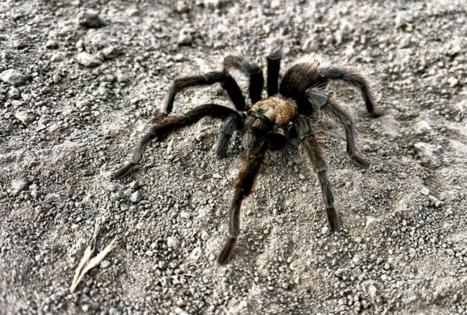It's tarantula mating season. Where you can spot the spider and how to avoid getting bit
Published in Science & Technology News
If you suffer from arachnophobia, this is the time of year when you're most likely to run into one of your worst nightmares: a tarantula.
It's mating season for most of the 29 species of tarantulas in the United States, 10 of which can be found in California, according to Los Padres National Forest. Around this time, tarantulas tend to leave their burrows to hunt for a mate — and they will travel up to 20 miles on their eight fuzzy legs to make a love connection.
In Southern California, the two most common species are the Mojave blonde tarantula Aphonopelma iodius, which resides in the Mojave desert area, and the California ebony tarantula Aphonopelma eutylenum, which lives in the south and eastern regions of San Diego and Imperial counties, said Danny McCamish, senior environmental scientist for the California State Parks.
During mating season, which begins in August and can last until December, male tarantulas leave their burrows in search of a mate.
"This highly visible behavior contrasts sharply with their otherwise cryptic, burrow-dwelling lifestyle," said McCamish.
Outside of mating season, tarantulas only emerge at night to hunt.
"Mating season for tarantulas is not uniform across the United States," McCamish said. "Instead, it depends heavily on regional climate, elevation and species-specific biology."
Where you'll find a tarantula looking for love
During mating season, tarantula sightings are common during dusk and nighttime hours, especially following warm days and before seasonal rains, McCamish said.
They can be spotted moving around in chaparral and shrub but also in the deserts and mountain areas, said Doug Yanega, senior scientist at UC Riverside's Entomology Research Museum.
One indicator of a possible tarantula sighting is a Tarantula hawk wasp buzzing around. This wasp hunts the spider to feed its offspring, according to the National Parks Service.
The large blue-black wasps with bright orange wings are "a much better way to estimate the spider population than trying to actually find the spiders, which are intensely secretive," Yanega said.
McCamish said some of the best-known locations for observing the California ebony tarantula include:
• Northeast desert region: Joshua Tree National Park, including Black Rock Canyon and the Cottonwood Spring area near the southern entrance to Joshua Tree. You'll also find the eight-legged creatures along the road (at night) in the Mojave Trails National Monument also known as the "Heart of the Mojave."
•Central Coast region: The oak woodlands of Kern County near Hart Park, the Los Padres National Forest north of Santa Barbara and in Ventura near Casitas Pass.
• Greater Los Angeles: Griffith Park, Runyon Canyon Park, Malibu Creek State Park, the Backbone Trail in the Santa Monica Mountains, Leo Carrillo State Park and Topanga Canyon.
• Southern desert and mountains: Eastern San Diego County including Cuyamaca Rancho State Park and the Stonewall Mine in the Laguna Mountain region. Anza-Borrego Desert State Park within the Colorado Desert of Southern California, particularly in the Borrego Palm Canyon and Yaqui Well areas.
Experts say the male spiders may travel up to 20 miles throughout the mating season to find a connection, but the distance depends on the weather, food availability and other environmental conditions.
While this is a solitary and competitive journey, you might wander across a swarm of tarantulas who happen to emerge at the same time.
"Anecdotally, people can experience this 'horde' or 'swarm' in the desert during mating season late at night, if conditions are right, when hundreds can be seen crossing remote desert roads slowly on their mating search, McCamish said.
How tarantulas court and the timeline for eggs hatching
When a male locates a female tarantula, he "initiates a courtship ritual involving rhythmic tapping and vibration to signal his presence and avoid predation," McCamish said.
If the female is receptive, mating occurs.
"Males don't live very long, and females often aggressively rebuff potential mates, so small or weak males may never successfully reproduce," Yanega added.
On average, males live seven to 10 years, whereas females can reach 20 to 25 years or more, according to experts.
After mating, the female may eat her counterpart, which is why some males try to escape.
The female will then store the sperm in structures called spermathecae and eventually construct an egg sac where the eggs remain until they hatch the following spring or summer, said Sarah Crews, from the California Academy of Sciences' department of entomology. The baby tarantulas are known as "spiderlings."
"The spiderlings probably hang out for a bit, then disperse and make their own burrows, likely not traveling too far," Crews said.
Can a tarantula kill or injure me?
Tarantulas are harmless unless grabbed.
Researchers say their bodies are covered with "irritant hairs" that, if touched, can cause dermatitis and a rash. When a spider needs to protect itself from a predator, it rubs its hairs to ward off the danger.
"This is why you sometimes see tarantulas with 'bald spots,'" Crews said. "They do it when they are stressed, so if you come across one and it starts doing that, best to leave it alone ... while it won't hurt humans, you don't want to stress out the poor guy — he has enough problems at this point".
Tarantulas are often vilified in movies, but they are actually shy, slow-moving and reluctant to bite.
Native tarantulas in the United States pose no serious threat to humans and only bite if severely provoked, McCamish said.
The venom from a tarantula bite typically won't kill a human, but it can cause minor pain, swelling or itching.
©2025 Los Angeles Times. Visit at latimes.com. Distributed by Tribune Content Agency, LLC.







Comments